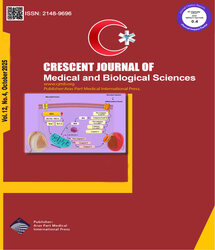Nov 2014, Vol 1, Issue 3



Advanced Search

For Author's & Reviewer's
Poll
How do you find the scientific quality of the published articles on our web site?
| Review | |
| A Study of Brucella Infection in Humans | |
| Mohammad Reza Hasanjani Roushan1, Sohrab Kazemi2, Fatemeh Fallah Rostami3, Soheil Ebrahimpour1 | |
| 1Infectious Diseases and Tropical Medicine Research Center, Babol University of Medical Sciences, Babol, Iran 2Cellular and Molecular Research Center, Babol University of Medical Sciences, Babol, Iran 3Undersecretary For Research and Technology, Ministry of Health and Medical Education, Pediatric Neuro Rehabilitation Research Center, University of Social Welfare and Rehabilitation Sciences, Tehran, Iran |
|
|
CJMB 2014; 1: 069-075 Viewed : 5930 times Downloaded : 2876 times. Keywords : Diagnostic test, Human Brucellosis, Therapeutic Regimen, Zoonotic |
|
| Full Text(PDF) | Related Articles | |
| Abstract | |
Objective: Brucellosis is the most usual zoonotic disease around the world especially in the Middle East,
Mediterranean and Indian sub-continent areas. This bacterium has ten species that Brucella melitensis
among them recognized as the most important cause of human brucellosis. This infection transfer ways to
human include of wounds, bacteria inhalation and consumption of septic dairy such as raw milk, cream
and butter. Brucellosis as a systemic disease can involve more organs of patients that have symptoms
such as fever, night sweating, and backache. This infection can be divided as acute, sub-acute and chronic
forms according to the manner of clinical presentation. Materials and Methods: This research is a review study and conducted by reviewing of the literature, which is related to this issue and also visiting, PubMed, and other linked websites. Results: In human brucellosis domestic animals are the main natural reservoir of infection. Whenever incidence rate of this infection in domestic and wild animals is reduced on the other hand incidence rate in human also will reduce. Conclusion: Blood cultures, serological tests and molecular tests are common laboratory methods of this infection. Diminution of relapse and therapeutic failure rates are as most important aim, which is researcher’s regards. |
Cite By, Google Scholar
Google Scholar
Articles by Hasanjani Reza Roushan M
Articles by Kazemi S
Articles by Fallah Rostami F
Articles by Ebrahimpour S
PubMed
Articles by Mohammad Reza Hasanjani Roushan
Articles by Sohrab Kazemi
Articles by Fatemeh Fallah Rostami
Articles by Soheil Ebrahimpour
Submit Paper
Online Submission System CJMB ENDNOTE ® Style
CJMB ENDNOTE ® Style
 Tutorials
Tutorials
 Publication Charge
Medical and Biological Research Center
About Journal
Publication Charge
Medical and Biological Research Center
About Journal
Online Submission System
 CJMB ENDNOTE ® Style
CJMB ENDNOTE ® Style
 Tutorials
Tutorials
 Publication Charge
Medical and Biological Research Center
About Journal
Publication Charge
Medical and Biological Research Center
About Journal
Publication Information
Publisher
Aras Part Medical International Press Editor-in-Chief
Arash Khaki
Deputy Editor
Zafer Akan
Aras Part Medical International Press Editor-in-Chief
Arash Khaki
Deputy Editor
Zafer Akan
Published Article Statistics

















